Recognizing the Different Sorts Of Garbage Disposal Techniques
In the world of waste management, the selection of disposal methods readily available today is substantial and varied, each method serving a distinctive purpose in addressing the obstacle of garbage disposal. click here. From recycling approaches that intend to provide brand-new life to products, to the intricate processes of unsafe waste management, the landscape of waste disposal is intricate yet essential for ecological sustainability. Understanding the nuances of these various strategies not just loses light on the importance of accountable waste administration but also prompts us to reconsider our approach in the direction of garbage disposal in a swiftly developing world

Recycling Methods
Recycling approaches are important for sustainable waste monitoring methods in both industrial and residential setups. medical waste removal. By applying efficient recycling techniques, a substantial amount of waste can be drawn away from garbage dumps, conserving all-natural resources and minimizing the environmental effect of production procedures
In suburbs, curbside recycling programs play a vital function in encouraging homes to separate recyclable products from general waste. Products such as paper, plastics, glass, and metals can be sorted and accumulated for processing right into brand-new products, minimizing the demand for basic materials and energy-intensive production processes.
Industrial facilities additionally count on reusing methods to reduce waste generation and advertise a circular economic climate. By implementing closed-loop systems, companies can recycle products within their production processes, lowering costs and environmental impact. medical waste removal. Furthermore, commercial recycling programs often include collaborations with specialized reusing centers to ensure that materials are appropriately arranged, refined, and rehabilitated into the supply chain
Composting Methods

Aerated static heap composting includes mixing natural waste products in a large pile and consistently transforming it to guarantee correct aeration. This technique is efficient for large composting operations. On the various other hand, vermicomposting uses earthworms to damage down organic issue into nutrient-rich spreadings. This method is well-suited for smaller-scale procedures and households.
In-vessel composting involves placing organic waste in a shut container with regulated problems for temperature and aeration. Windrow composting includes developing long rows of natural waste and consistently transforming them to promote decomposition - medical waste disposal.
Landfill Disposal
Land fill disposal is a frequently used technique for handling waste that can not be recycled or composted. Methane gas, a byproduct of decaying natural waste in landfills, is commonly collected and used as a resource of sustainable energy. Efforts to lower dependence on garbage dumps include advertising waste reduction, recycling, and discovering alternate waste disposal methods to minimize the ecological footprint associated with typical garbage dump disposal practices.

Waste-to-Energy Incineration
Incineration of waste for power generation is a method progressively being taken into consideration as an option to standard click for source landfill disposal techniques. Waste-to-energy incineration includes the burning of waste materials at high temperatures, normally in specialized centers developed to produce power or warmth via the process - click here. This technique not just lowers the volume of waste that would or else be predestined for landfills however additionally utilizes the warm generated during incineration to create energy
Among the vital advantages of waste-to-energy incineration is its ability to produce power while minimizing the environmental effect compared to traditional land fill disposal methods. By transforming waste right into power, this method assists in minimizing greenhouse gas exhausts and dependence on fossil gas for power generation. Additionally, waste-to-energy facilities are geared up with sophisticated air pollution control innovations to alleviate possible toxic wastes launched throughout the burning procedure.
Contaminated Materials Administration

Considering the critical importance of responsible waste monitoring techniques, especially in the realm of environmental sustainability, the emphasis currently moves towards the intricate domain name of Contaminated materials Administration. Dangerous waste positions significant threats to both human health and wellness and the atmosphere, necessitating customized handling and disposal strategies. Typical examples of unsafe waste consist of chemicals, batteries, pesticides, and electronic waste.
Contaminated materials Monitoring includes the identification, collection, transport, treatment, and disposal of products considered potentially hazardous or damaging. This procedure needs adherence to strict guidelines and guidelines to minimize unfavorable influences on ecological communities and public health. Numerous methods are employed in managing contaminated materials, including recycling, safe and secure garbage dumps, encapsulation, and chemical therapy.
Proper Unsafe Waste Management is critical for avoiding contamination of dirt, water sources, and air contamination. It is essential for markets, research laboratories, healthcare centers, and various other generators of contaminated materials to carry out durable management methods, training programs, and emergency situation reaction prepares to make certain the safe handling and disposal of these materials. Failing to take care of dangerous waste properly can have far-ranging consequences, underscoring the value of attentive and responsible methods in this area.
Verdict
In final thought, waste disposal techniques play an essential role in managing and decreasing the influence of waste on the setting. It is crucial for individuals and industries to comprehend the different waste disposal techniques readily available and pick the most proper method for sustainable waste monitoring.
In the world of waste management, the array of disposal strategies offered today is large and varied, each approach serving a distinct objective in attending to the challenge of waste disposal. click here. From reusing techniques that aim to give brand-new life to products, to the complex processes of dangerous waste management, the landscape of waste disposal is complex yet critical for ecological sustainability. Comprehending the nuances of these various methods not only loses light on the significance of responsible waste monitoring however also motivates us to reconsider our approach in the direction of waste disposal in a quickly advancing world
Initiatives to minimize reliance on land fills include advertising waste reduction, reusing, and exploring different waste disposal techniques to minimize the environmental impact connected with traditional garbage dump disposal practices.
It is crucial for individuals and markets to recognize the different waste disposal strategies available and select the most ideal approach for lasting waste monitoring.
Comments on “Environmental Responsibility: The Eco-Friendly Method to Medical Waste Disposal”